MGT302A/BIZ303 Strategic Analysis: Woolworths Business Environment
VerifiedAdded on 2023/06/03
|11
|2955
|362
Case Study
AI Summary
This case study report delves into the strategic position of Woolworths in the Australian retail market. It conducts an external analysis using Porter's Five Forces and PESTLE framework, evaluating the bargaining power of suppliers and buyers, industry rivalry, the threat of new entrants and substitutes, and various social, technological, and economic factors. Internal analysis explores Woolworths' core competencies, including integration, innovation, human resources, and brand reputation, alongside a value chain analysis. The report identifies Woolworths' main competitors, such as Wesfarmers and Aldi, and discusses the company's vision and goals, emphasizing its commitment to customer service and sustainability. It examines the cost leadership and differentiation strategies employed by Woolworths, recommending further steps to enhance its competitive advantage. The document concludes with a critique of the cost leadership strategy and suggests innovative approaches for future growth. Desklib is a valuable resource for students seeking similar case studies and solved assignments.
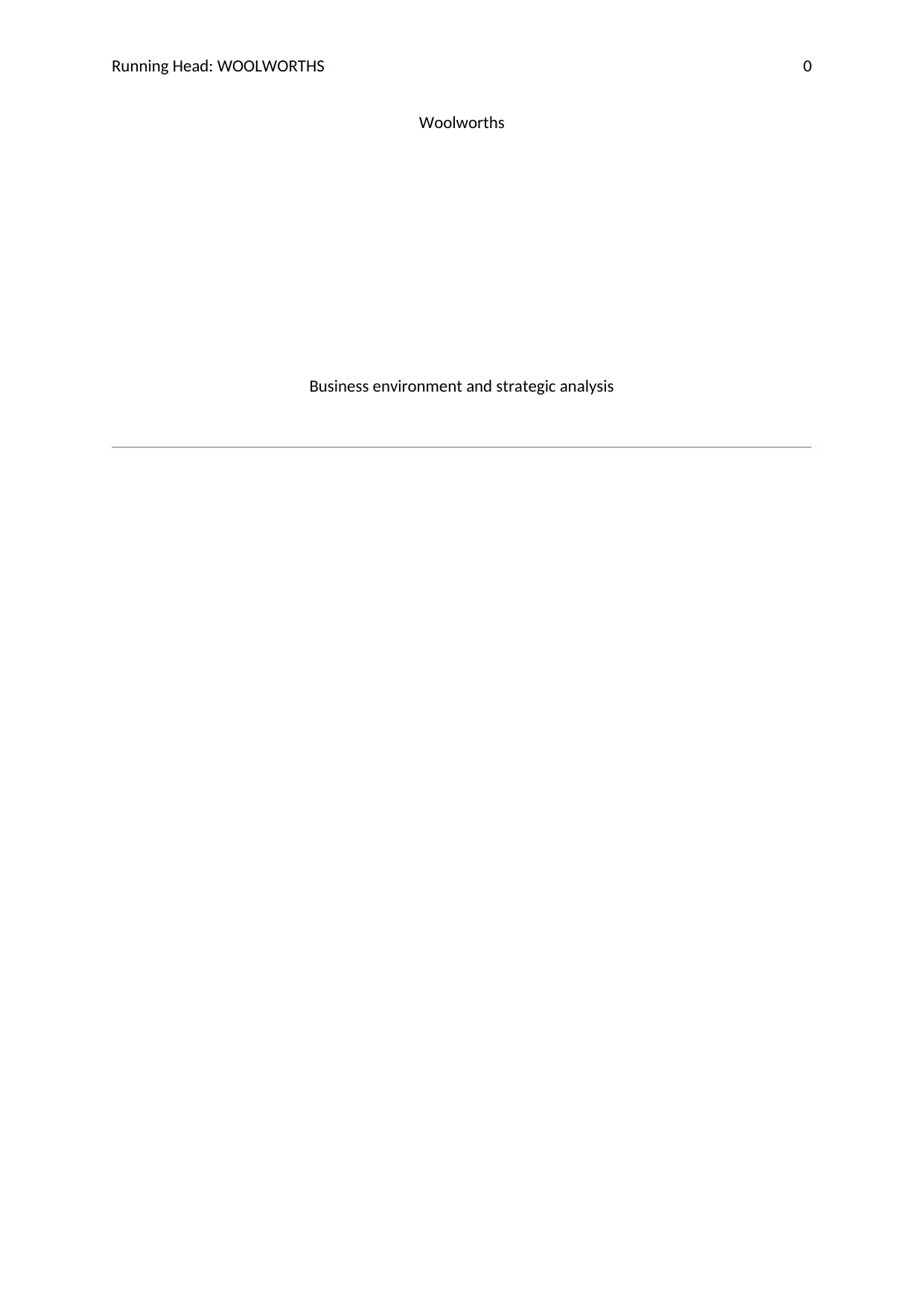
Running Head: WOOLWORTHS 0
Woolworths
Business environment and strategic analysis
Woolworths
Business environment and strategic analysis
Paraphrase This Document
Need a fresh take? Get an instant paraphrase of this document with our AI Paraphraser
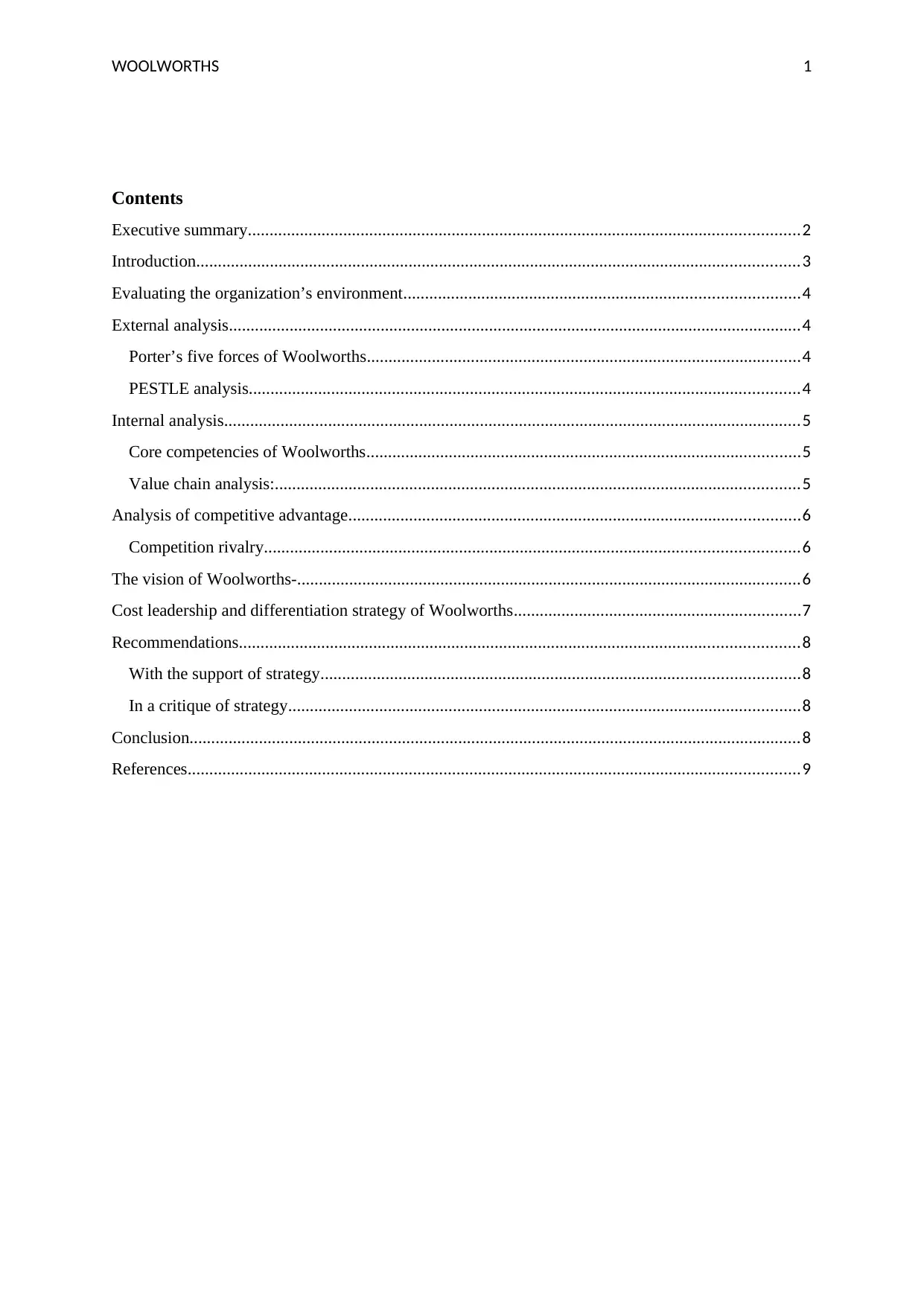
WOOLWORTHS 1
Contents
Executive summary...............................................................................................................................2
Introduction...........................................................................................................................................3
Evaluating the organization’s environment...........................................................................................4
External analysis....................................................................................................................................4
Porter’s five forces of Woolworths....................................................................................................4
PESTLE analysis...............................................................................................................................4
Internal analysis.....................................................................................................................................5
Core competencies of Woolworths....................................................................................................5
Value chain analysis:.........................................................................................................................5
Analysis of competitive advantage........................................................................................................6
Competition rivalry...........................................................................................................................6
The vision of Woolworths-....................................................................................................................6
Cost leadership and differentiation strategy of Woolworths..................................................................7
Recommendations.................................................................................................................................8
With the support of strategy..............................................................................................................8
In a critique of strategy......................................................................................................................8
Conclusion.............................................................................................................................................8
References.............................................................................................................................................9
Contents
Executive summary...............................................................................................................................2
Introduction...........................................................................................................................................3
Evaluating the organization’s environment...........................................................................................4
External analysis....................................................................................................................................4
Porter’s five forces of Woolworths....................................................................................................4
PESTLE analysis...............................................................................................................................4
Internal analysis.....................................................................................................................................5
Core competencies of Woolworths....................................................................................................5
Value chain analysis:.........................................................................................................................5
Analysis of competitive advantage........................................................................................................6
Competition rivalry...........................................................................................................................6
The vision of Woolworths-....................................................................................................................6
Cost leadership and differentiation strategy of Woolworths..................................................................7
Recommendations.................................................................................................................................8
With the support of strategy..............................................................................................................8
In a critique of strategy......................................................................................................................8
Conclusion.............................................................................................................................................8
References.............................................................................................................................................9
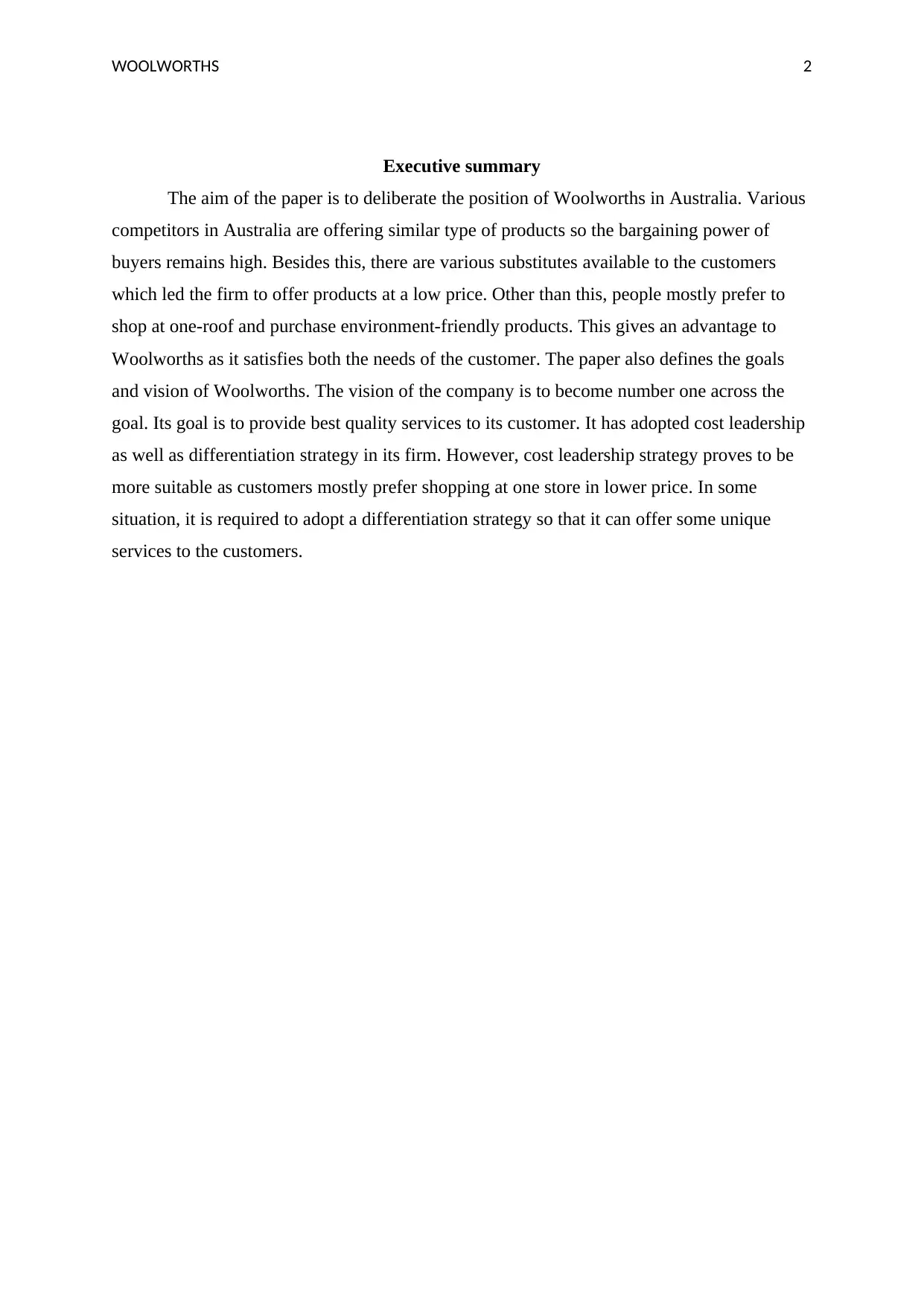
WOOLWORTHS 2
Executive summary
The aim of the paper is to deliberate the position of Woolworths in Australia. Various
competitors in Australia are offering similar type of products so the bargaining power of
buyers remains high. Besides this, there are various substitutes available to the customers
which led the firm to offer products at a low price. Other than this, people mostly prefer to
shop at one-roof and purchase environment-friendly products. This gives an advantage to
Woolworths as it satisfies both the needs of the customer. The paper also defines the goals
and vision of Woolworths. The vision of the company is to become number one across the
goal. Its goal is to provide best quality services to its customer. It has adopted cost leadership
as well as differentiation strategy in its firm. However, cost leadership strategy proves to be
more suitable as customers mostly prefer shopping at one store in lower price. In some
situation, it is required to adopt a differentiation strategy so that it can offer some unique
services to the customers.
Executive summary
The aim of the paper is to deliberate the position of Woolworths in Australia. Various
competitors in Australia are offering similar type of products so the bargaining power of
buyers remains high. Besides this, there are various substitutes available to the customers
which led the firm to offer products at a low price. Other than this, people mostly prefer to
shop at one-roof and purchase environment-friendly products. This gives an advantage to
Woolworths as it satisfies both the needs of the customer. The paper also defines the goals
and vision of Woolworths. The vision of the company is to become number one across the
goal. Its goal is to provide best quality services to its customer. It has adopted cost leadership
as well as differentiation strategy in its firm. However, cost leadership strategy proves to be
more suitable as customers mostly prefer shopping at one store in lower price. In some
situation, it is required to adopt a differentiation strategy so that it can offer some unique
services to the customers.
⊘ This is a preview!⊘
Do you want full access?
Subscribe today to unlock all pages.

Trusted by 1+ million students worldwide
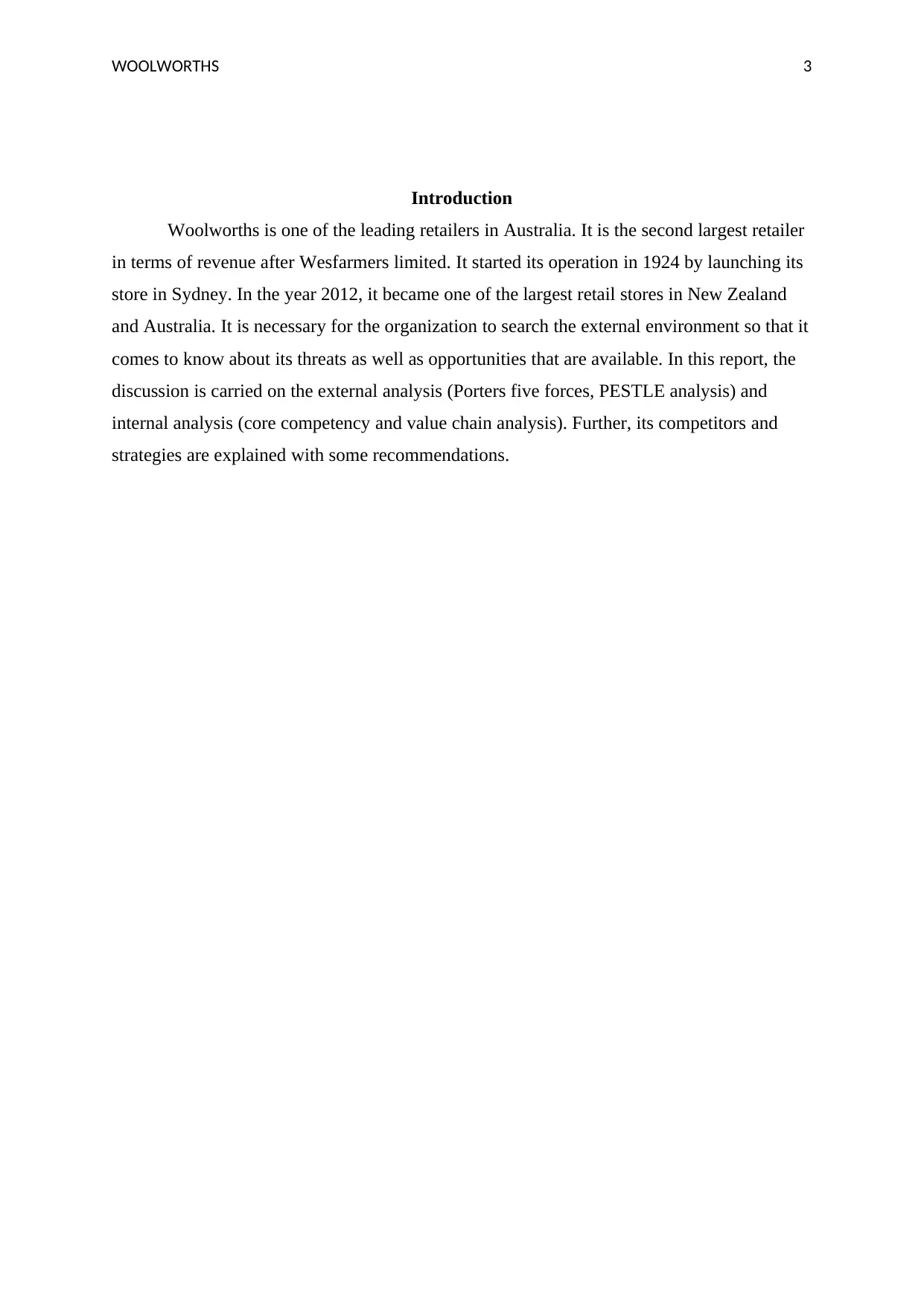
WOOLWORTHS 3
Introduction
Woolworths is one of the leading retailers in Australia. It is the second largest retailer
in terms of revenue after Wesfarmers limited. It started its operation in 1924 by launching its
store in Sydney. In the year 2012, it became one of the largest retail stores in New Zealand
and Australia. It is necessary for the organization to search the external environment so that it
comes to know about its threats as well as opportunities that are available. In this report, the
discussion is carried on the external analysis (Porters five forces, PESTLE analysis) and
internal analysis (core competency and value chain analysis). Further, its competitors and
strategies are explained with some recommendations.
Introduction
Woolworths is one of the leading retailers in Australia. It is the second largest retailer
in terms of revenue after Wesfarmers limited. It started its operation in 1924 by launching its
store in Sydney. In the year 2012, it became one of the largest retail stores in New Zealand
and Australia. It is necessary for the organization to search the external environment so that it
comes to know about its threats as well as opportunities that are available. In this report, the
discussion is carried on the external analysis (Porters five forces, PESTLE analysis) and
internal analysis (core competency and value chain analysis). Further, its competitors and
strategies are explained with some recommendations.
Paraphrase This Document
Need a fresh take? Get an instant paraphrase of this document with our AI Paraphraser
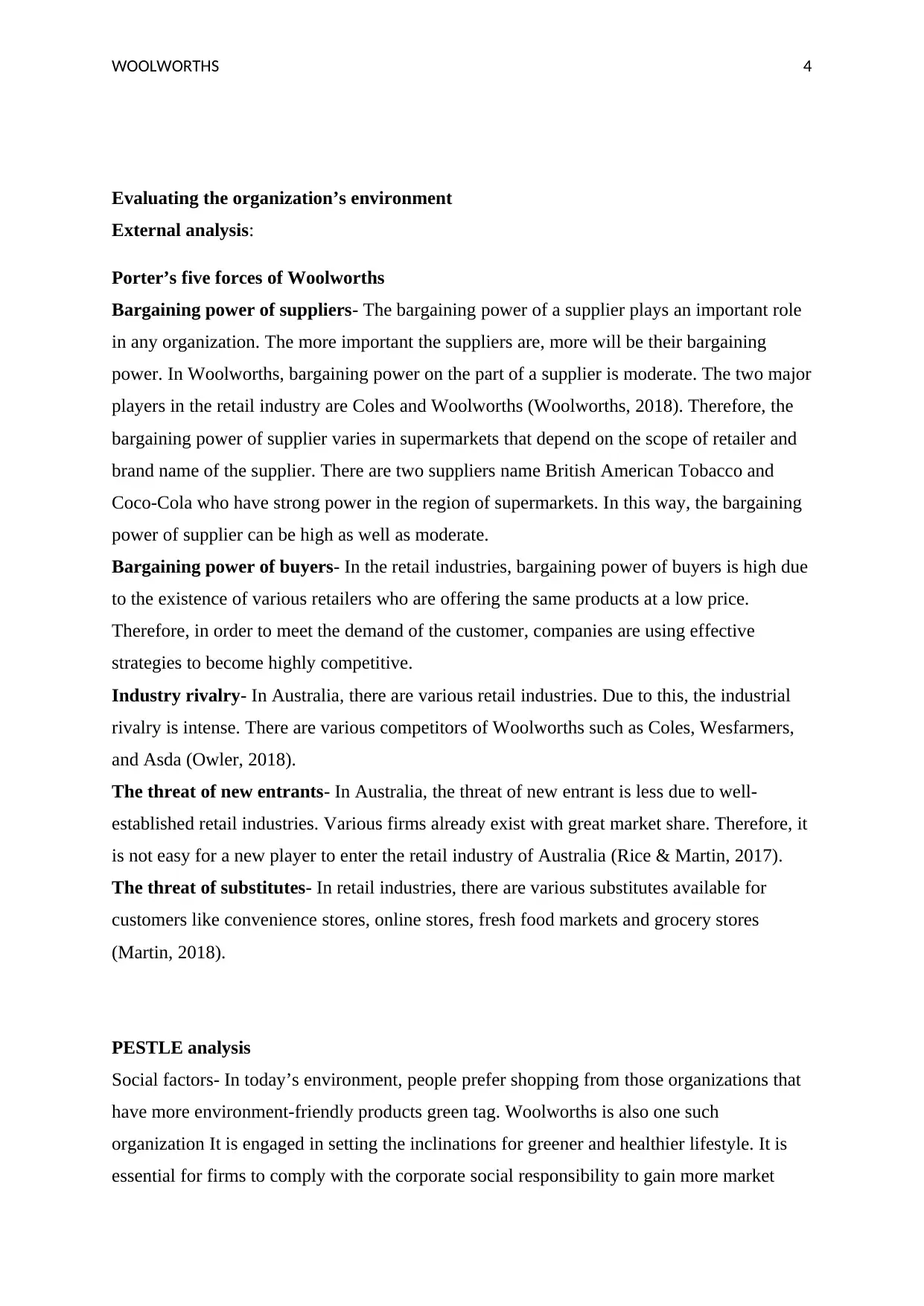
WOOLWORTHS 4
Evaluating the organization’s environment
External analysis:
Porter’s five forces of Woolworths
Bargaining power of suppliers- The bargaining power of a supplier plays an important role
in any organization. The more important the suppliers are, more will be their bargaining
power. In Woolworths, bargaining power on the part of a supplier is moderate. The two major
players in the retail industry are Coles and Woolworths (Woolworths, 2018). Therefore, the
bargaining power of supplier varies in supermarkets that depend on the scope of retailer and
brand name of the supplier. There are two suppliers name British American Tobacco and
Coco-Cola who have strong power in the region of supermarkets. In this way, the bargaining
power of supplier can be high as well as moderate.
Bargaining power of buyers- In the retail industries, bargaining power of buyers is high due
to the existence of various retailers who are offering the same products at a low price.
Therefore, in order to meet the demand of the customer, companies are using effective
strategies to become highly competitive.
Industry rivalry- In Australia, there are various retail industries. Due to this, the industrial
rivalry is intense. There are various competitors of Woolworths such as Coles, Wesfarmers,
and Asda (Owler, 2018).
The threat of new entrants- In Australia, the threat of new entrant is less due to well-
established retail industries. Various firms already exist with great market share. Therefore, it
is not easy for a new player to enter the retail industry of Australia (Rice & Martin, 2017).
The threat of substitutes- In retail industries, there are various substitutes available for
customers like convenience stores, online stores, fresh food markets and grocery stores
(Martin, 2018).
PESTLE analysis
Social factors- In today’s environment, people prefer shopping from those organizations that
have more environment-friendly products green tag. Woolworths is also one such
organization It is engaged in setting the inclinations for greener and healthier lifestyle. It is
essential for firms to comply with the corporate social responsibility to gain more market
Evaluating the organization’s environment
External analysis:
Porter’s five forces of Woolworths
Bargaining power of suppliers- The bargaining power of a supplier plays an important role
in any organization. The more important the suppliers are, more will be their bargaining
power. In Woolworths, bargaining power on the part of a supplier is moderate. The two major
players in the retail industry are Coles and Woolworths (Woolworths, 2018). Therefore, the
bargaining power of supplier varies in supermarkets that depend on the scope of retailer and
brand name of the supplier. There are two suppliers name British American Tobacco and
Coco-Cola who have strong power in the region of supermarkets. In this way, the bargaining
power of supplier can be high as well as moderate.
Bargaining power of buyers- In the retail industries, bargaining power of buyers is high due
to the existence of various retailers who are offering the same products at a low price.
Therefore, in order to meet the demand of the customer, companies are using effective
strategies to become highly competitive.
Industry rivalry- In Australia, there are various retail industries. Due to this, the industrial
rivalry is intense. There are various competitors of Woolworths such as Coles, Wesfarmers,
and Asda (Owler, 2018).
The threat of new entrants- In Australia, the threat of new entrant is less due to well-
established retail industries. Various firms already exist with great market share. Therefore, it
is not easy for a new player to enter the retail industry of Australia (Rice & Martin, 2017).
The threat of substitutes- In retail industries, there are various substitutes available for
customers like convenience stores, online stores, fresh food markets and grocery stores
(Martin, 2018).
PESTLE analysis
Social factors- In today’s environment, people prefer shopping from those organizations that
have more environment-friendly products green tag. Woolworths is also one such
organization It is engaged in setting the inclinations for greener and healthier lifestyle. It is
essential for firms to comply with the corporate social responsibility to gain more market
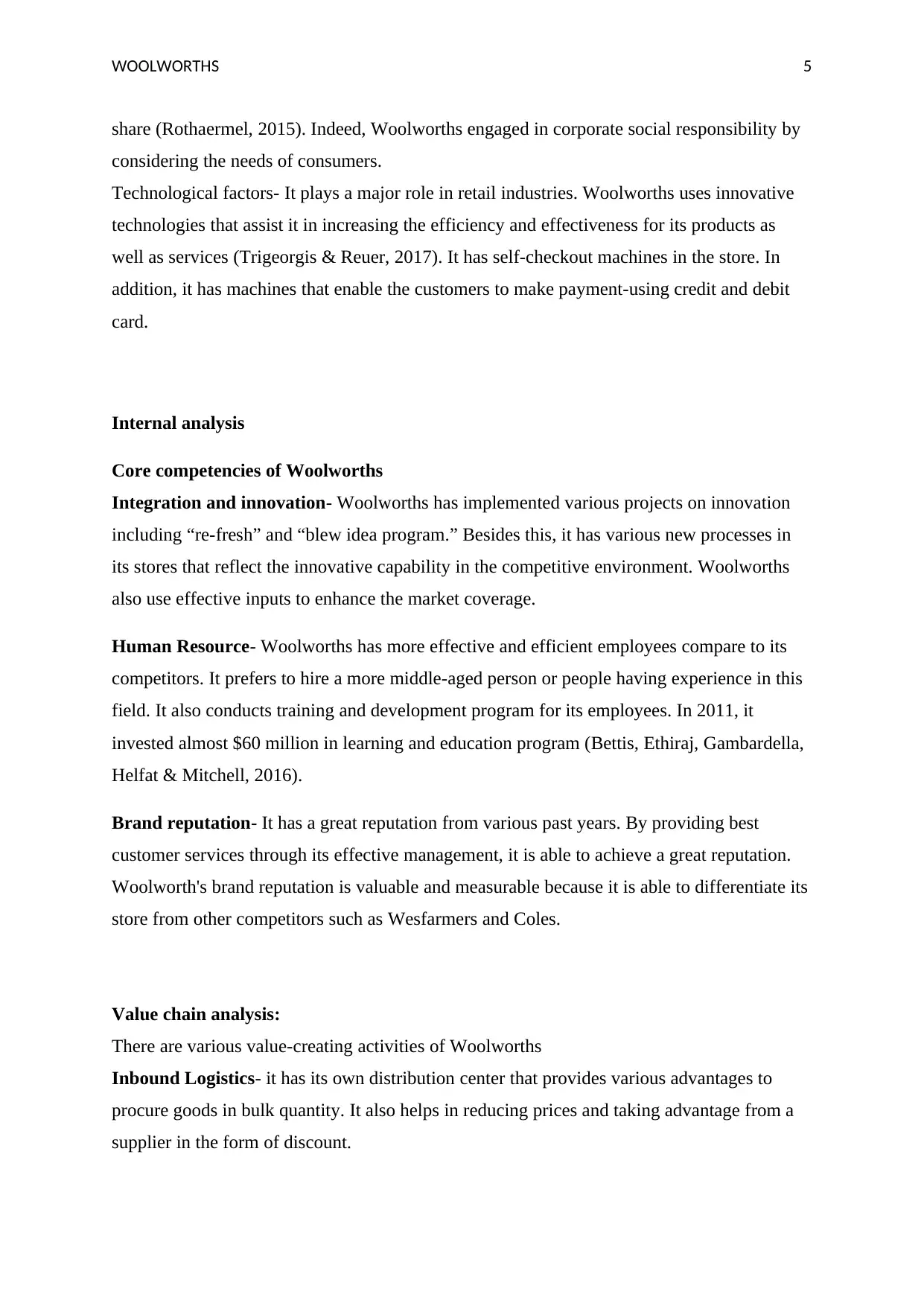
WOOLWORTHS 5
share (Rothaermel, 2015). Indeed, Woolworths engaged in corporate social responsibility by
considering the needs of consumers.
Technological factors- It plays a major role in retail industries. Woolworths uses innovative
technologies that assist it in increasing the efficiency and effectiveness for its products as
well as services (Trigeorgis & Reuer, 2017). It has self-checkout machines in the store. In
addition, it has machines that enable the customers to make payment-using credit and debit
card.
Internal analysis
Core competencies of Woolworths
Integration and innovation- Woolworths has implemented various projects on innovation
including “re-fresh” and “blew idea program.” Besides this, it has various new processes in
its stores that reflect the innovative capability in the competitive environment. Woolworths
also use effective inputs to enhance the market coverage.
Human Resource- Woolworths has more effective and efficient employees compare to its
competitors. It prefers to hire a more middle-aged person or people having experience in this
field. It also conducts training and development program for its employees. In 2011, it
invested almost $60 million in learning and education program (Bettis, Ethiraj, Gambardella,
Helfat & Mitchell, 2016).
Brand reputation- It has a great reputation from various past years. By providing best
customer services through its effective management, it is able to achieve a great reputation.
Woolworth's brand reputation is valuable and measurable because it is able to differentiate its
store from other competitors such as Wesfarmers and Coles.
Value chain analysis:
There are various value-creating activities of Woolworths
Inbound Logistics- it has its own distribution center that provides various advantages to
procure goods in bulk quantity. It also helps in reducing prices and taking advantage from a
supplier in the form of discount.
share (Rothaermel, 2015). Indeed, Woolworths engaged in corporate social responsibility by
considering the needs of consumers.
Technological factors- It plays a major role in retail industries. Woolworths uses innovative
technologies that assist it in increasing the efficiency and effectiveness for its products as
well as services (Trigeorgis & Reuer, 2017). It has self-checkout machines in the store. In
addition, it has machines that enable the customers to make payment-using credit and debit
card.
Internal analysis
Core competencies of Woolworths
Integration and innovation- Woolworths has implemented various projects on innovation
including “re-fresh” and “blew idea program.” Besides this, it has various new processes in
its stores that reflect the innovative capability in the competitive environment. Woolworths
also use effective inputs to enhance the market coverage.
Human Resource- Woolworths has more effective and efficient employees compare to its
competitors. It prefers to hire a more middle-aged person or people having experience in this
field. It also conducts training and development program for its employees. In 2011, it
invested almost $60 million in learning and education program (Bettis, Ethiraj, Gambardella,
Helfat & Mitchell, 2016).
Brand reputation- It has a great reputation from various past years. By providing best
customer services through its effective management, it is able to achieve a great reputation.
Woolworth's brand reputation is valuable and measurable because it is able to differentiate its
store from other competitors such as Wesfarmers and Coles.
Value chain analysis:
There are various value-creating activities of Woolworths
Inbound Logistics- it has its own distribution center that provides various advantages to
procure goods in bulk quantity. It also helps in reducing prices and taking advantage from a
supplier in the form of discount.
⊘ This is a preview!⊘
Do you want full access?
Subscribe today to unlock all pages.

Trusted by 1+ million students worldwide
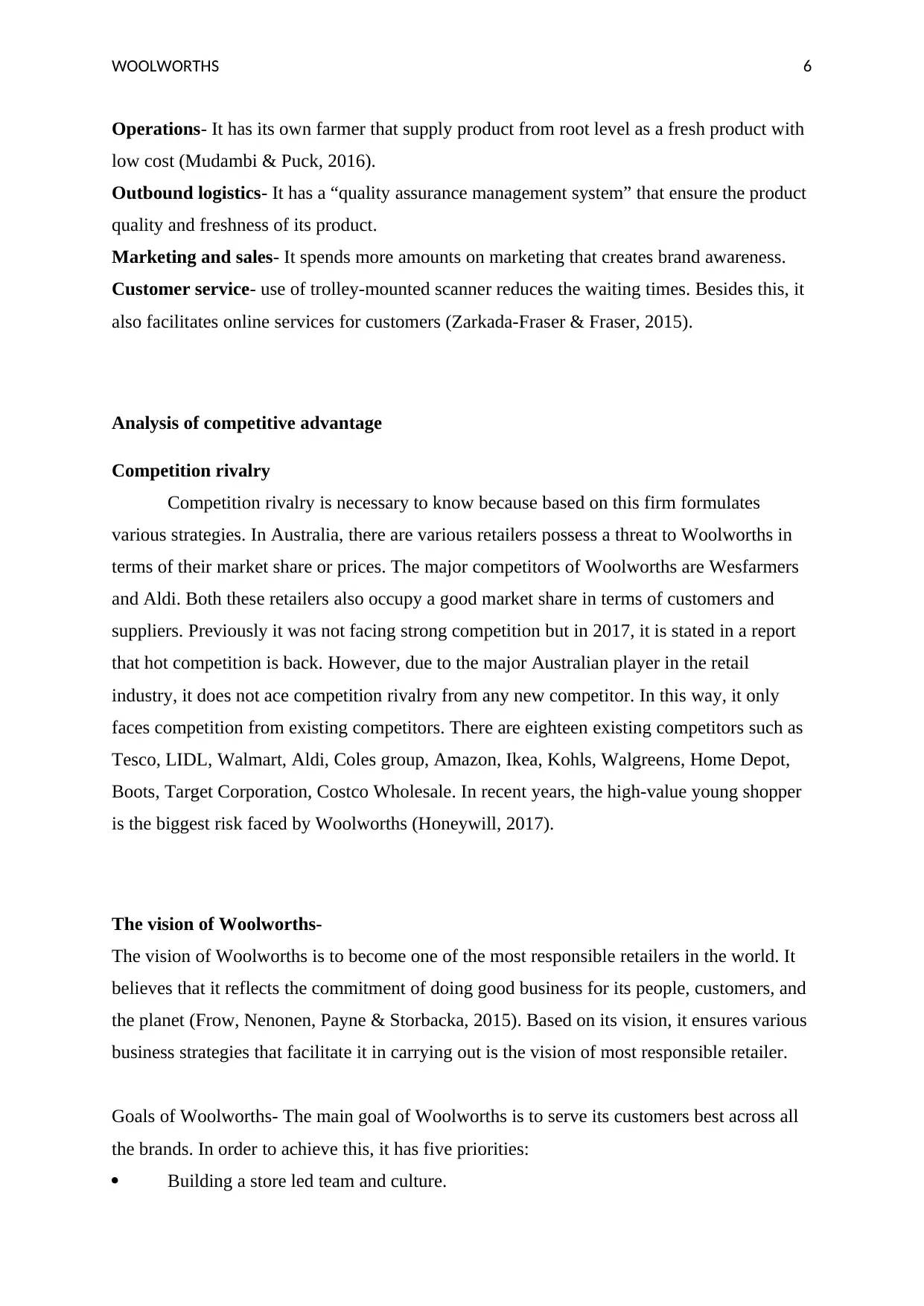
WOOLWORTHS 6
Operations- It has its own farmer that supply product from root level as a fresh product with
low cost (Mudambi & Puck, 2016).
Outbound logistics- It has a “quality assurance management system” that ensure the product
quality and freshness of its product.
Marketing and sales- It spends more amounts on marketing that creates brand awareness.
Customer service- use of trolley-mounted scanner reduces the waiting times. Besides this, it
also facilitates online services for customers (Zarkada-Fraser & Fraser, 2015).
Analysis of competitive advantage
Competition rivalry
Competition rivalry is necessary to know because based on this firm formulates
various strategies. In Australia, there are various retailers possess a threat to Woolworths in
terms of their market share or prices. The major competitors of Woolworths are Wesfarmers
and Aldi. Both these retailers also occupy a good market share in terms of customers and
suppliers. Previously it was not facing strong competition but in 2017, it is stated in a report
that hot competition is back. However, due to the major Australian player in the retail
industry, it does not ace competition rivalry from any new competitor. In this way, it only
faces competition from existing competitors. There are eighteen existing competitors such as
Tesco, LIDL, Walmart, Aldi, Coles group, Amazon, Ikea, Kohls, Walgreens, Home Depot,
Boots, Target Corporation, Costco Wholesale. In recent years, the high-value young shopper
is the biggest risk faced by Woolworths (Honeywill, 2017).
The vision of Woolworths-
The vision of Woolworths is to become one of the most responsible retailers in the world. It
believes that it reflects the commitment of doing good business for its people, customers, and
the planet (Frow, Nenonen, Payne & Storbacka, 2015). Based on its vision, it ensures various
business strategies that facilitate it in carrying out is the vision of most responsible retailer.
Goals of Woolworths- The main goal of Woolworths is to serve its customers best across all
the brands. In order to achieve this, it has five priorities:
Building a store led team and culture.
Operations- It has its own farmer that supply product from root level as a fresh product with
low cost (Mudambi & Puck, 2016).
Outbound logistics- It has a “quality assurance management system” that ensure the product
quality and freshness of its product.
Marketing and sales- It spends more amounts on marketing that creates brand awareness.
Customer service- use of trolley-mounted scanner reduces the waiting times. Besides this, it
also facilitates online services for customers (Zarkada-Fraser & Fraser, 2015).
Analysis of competitive advantage
Competition rivalry
Competition rivalry is necessary to know because based on this firm formulates
various strategies. In Australia, there are various retailers possess a threat to Woolworths in
terms of their market share or prices. The major competitors of Woolworths are Wesfarmers
and Aldi. Both these retailers also occupy a good market share in terms of customers and
suppliers. Previously it was not facing strong competition but in 2017, it is stated in a report
that hot competition is back. However, due to the major Australian player in the retail
industry, it does not ace competition rivalry from any new competitor. In this way, it only
faces competition from existing competitors. There are eighteen existing competitors such as
Tesco, LIDL, Walmart, Aldi, Coles group, Amazon, Ikea, Kohls, Walgreens, Home Depot,
Boots, Target Corporation, Costco Wholesale. In recent years, the high-value young shopper
is the biggest risk faced by Woolworths (Honeywill, 2017).
The vision of Woolworths-
The vision of Woolworths is to become one of the most responsible retailers in the world. It
believes that it reflects the commitment of doing good business for its people, customers, and
the planet (Frow, Nenonen, Payne & Storbacka, 2015). Based on its vision, it ensures various
business strategies that facilitate it in carrying out is the vision of most responsible retailer.
Goals of Woolworths- The main goal of Woolworths is to serve its customers best across all
the brands. In order to achieve this, it has five priorities:
Building a store led team and culture.
Paraphrase This Document
Need a fresh take? Get an instant paraphrase of this document with our AI Paraphraser
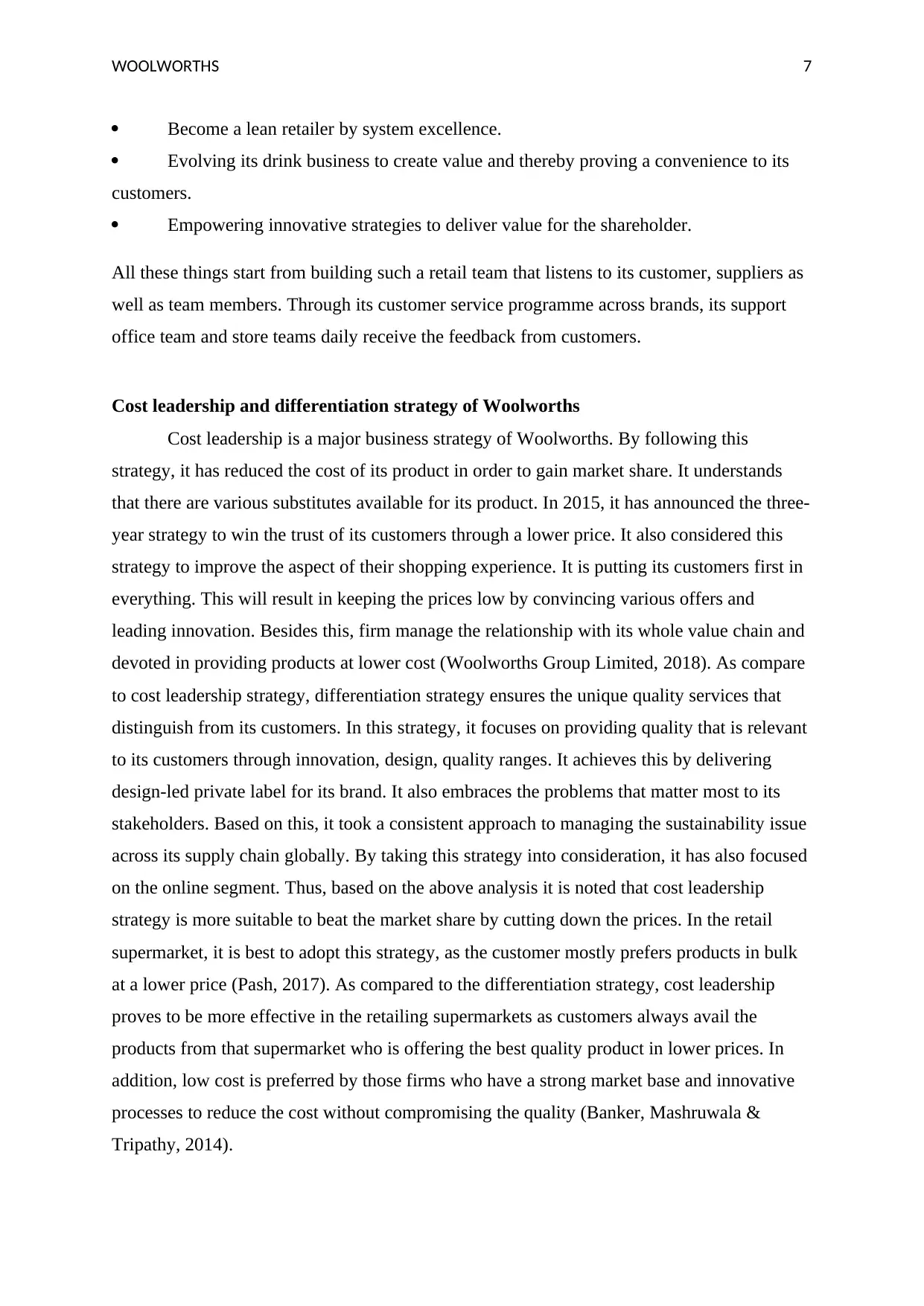
WOOLWORTHS 7
Become a lean retailer by system excellence.
Evolving its drink business to create value and thereby proving a convenience to its
customers.
Empowering innovative strategies to deliver value for the shareholder.
All these things start from building such a retail team that listens to its customer, suppliers as
well as team members. Through its customer service programme across brands, its support
office team and store teams daily receive the feedback from customers.
Cost leadership and differentiation strategy of Woolworths
Cost leadership is a major business strategy of Woolworths. By following this
strategy, it has reduced the cost of its product in order to gain market share. It understands
that there are various substitutes available for its product. In 2015, it has announced the three-
year strategy to win the trust of its customers through a lower price. It also considered this
strategy to improve the aspect of their shopping experience. It is putting its customers first in
everything. This will result in keeping the prices low by convincing various offers and
leading innovation. Besides this, firm manage the relationship with its whole value chain and
devoted in providing products at lower cost (Woolworths Group Limited, 2018). As compare
to cost leadership strategy, differentiation strategy ensures the unique quality services that
distinguish from its customers. In this strategy, it focuses on providing quality that is relevant
to its customers through innovation, design, quality ranges. It achieves this by delivering
design-led private label for its brand. It also embraces the problems that matter most to its
stakeholders. Based on this, it took a consistent approach to managing the sustainability issue
across its supply chain globally. By taking this strategy into consideration, it has also focused
on the online segment. Thus, based on the above analysis it is noted that cost leadership
strategy is more suitable to beat the market share by cutting down the prices. In the retail
supermarket, it is best to adopt this strategy, as the customer mostly prefers products in bulk
at a lower price (Pash, 2017). As compared to the differentiation strategy, cost leadership
proves to be more effective in the retailing supermarkets as customers always avail the
products from that supermarket who is offering the best quality product in lower prices. In
addition, low cost is preferred by those firms who have a strong market base and innovative
processes to reduce the cost without compromising the quality (Banker, Mashruwala &
Tripathy, 2014).
Become a lean retailer by system excellence.
Evolving its drink business to create value and thereby proving a convenience to its
customers.
Empowering innovative strategies to deliver value for the shareholder.
All these things start from building such a retail team that listens to its customer, suppliers as
well as team members. Through its customer service programme across brands, its support
office team and store teams daily receive the feedback from customers.
Cost leadership and differentiation strategy of Woolworths
Cost leadership is a major business strategy of Woolworths. By following this
strategy, it has reduced the cost of its product in order to gain market share. It understands
that there are various substitutes available for its product. In 2015, it has announced the three-
year strategy to win the trust of its customers through a lower price. It also considered this
strategy to improve the aspect of their shopping experience. It is putting its customers first in
everything. This will result in keeping the prices low by convincing various offers and
leading innovation. Besides this, firm manage the relationship with its whole value chain and
devoted in providing products at lower cost (Woolworths Group Limited, 2018). As compare
to cost leadership strategy, differentiation strategy ensures the unique quality services that
distinguish from its customers. In this strategy, it focuses on providing quality that is relevant
to its customers through innovation, design, quality ranges. It achieves this by delivering
design-led private label for its brand. It also embraces the problems that matter most to its
stakeholders. Based on this, it took a consistent approach to managing the sustainability issue
across its supply chain globally. By taking this strategy into consideration, it has also focused
on the online segment. Thus, based on the above analysis it is noted that cost leadership
strategy is more suitable to beat the market share by cutting down the prices. In the retail
supermarket, it is best to adopt this strategy, as the customer mostly prefers products in bulk
at a lower price (Pash, 2017). As compared to the differentiation strategy, cost leadership
proves to be more effective in the retailing supermarkets as customers always avail the
products from that supermarket who is offering the best quality product in lower prices. In
addition, low cost is preferred by those firms who have a strong market base and innovative
processes to reduce the cost without compromising the quality (Banker, Mashruwala &
Tripathy, 2014).
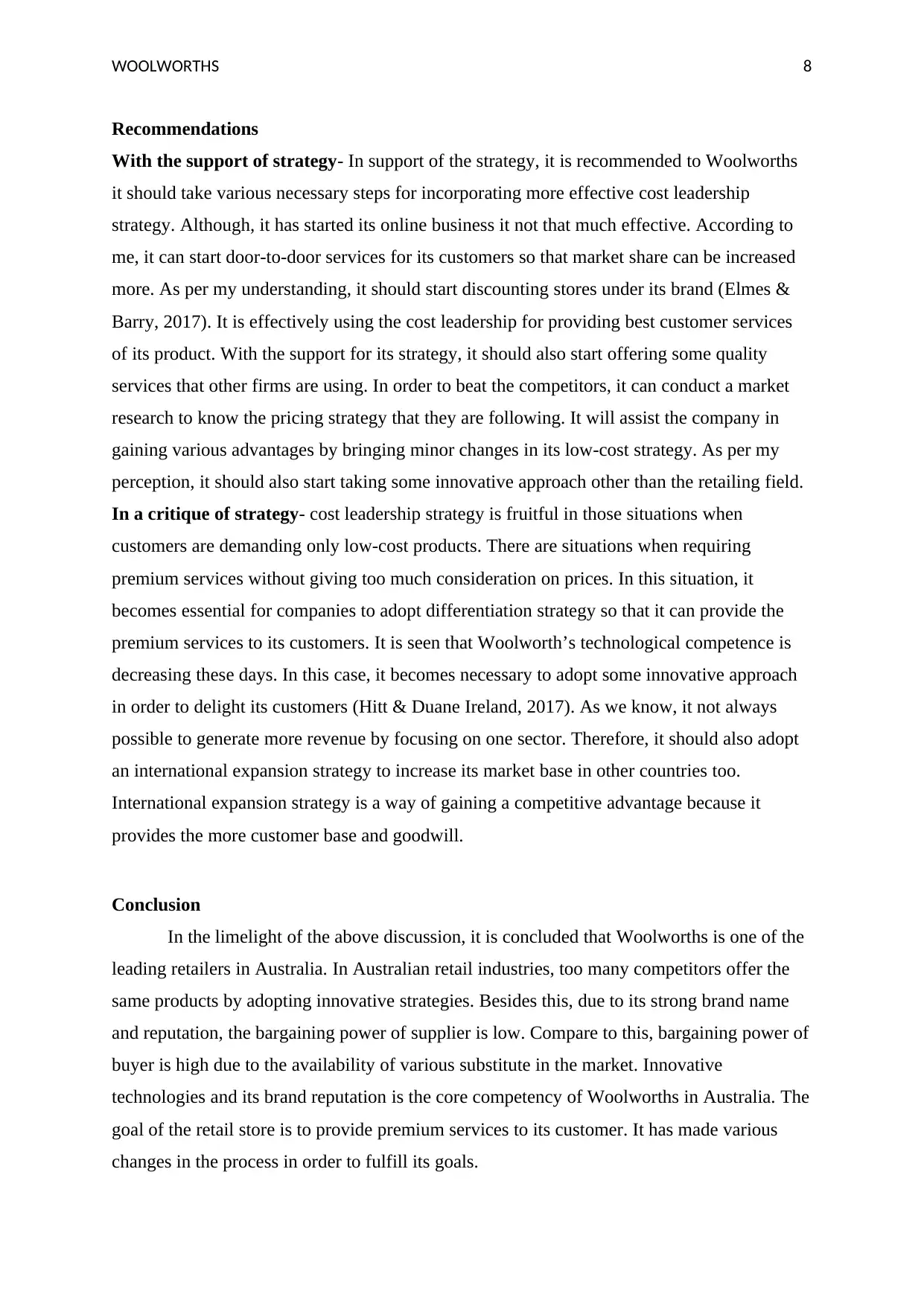
WOOLWORTHS 8
Recommendations
With the support of strategy- In support of the strategy, it is recommended to Woolworths
it should take various necessary steps for incorporating more effective cost leadership
strategy. Although, it has started its online business it not that much effective. According to
me, it can start door-to-door services for its customers so that market share can be increased
more. As per my understanding, it should start discounting stores under its brand (Elmes &
Barry, 2017). It is effectively using the cost leadership for providing best customer services
of its product. With the support for its strategy, it should also start offering some quality
services that other firms are using. In order to beat the competitors, it can conduct a market
research to know the pricing strategy that they are following. It will assist the company in
gaining various advantages by bringing minor changes in its low-cost strategy. As per my
perception, it should also start taking some innovative approach other than the retailing field.
In a critique of strategy- cost leadership strategy is fruitful in those situations when
customers are demanding only low-cost products. There are situations when requiring
premium services without giving too much consideration on prices. In this situation, it
becomes essential for companies to adopt differentiation strategy so that it can provide the
premium services to its customers. It is seen that Woolworth’s technological competence is
decreasing these days. In this case, it becomes necessary to adopt some innovative approach
in order to delight its customers (Hitt & Duane Ireland, 2017). As we know, it not always
possible to generate more revenue by focusing on one sector. Therefore, it should also adopt
an international expansion strategy to increase its market base in other countries too.
International expansion strategy is a way of gaining a competitive advantage because it
provides the more customer base and goodwill.
Conclusion
In the limelight of the above discussion, it is concluded that Woolworths is one of the
leading retailers in Australia. In Australian retail industries, too many competitors offer the
same products by adopting innovative strategies. Besides this, due to its strong brand name
and reputation, the bargaining power of supplier is low. Compare to this, bargaining power of
buyer is high due to the availability of various substitute in the market. Innovative
technologies and its brand reputation is the core competency of Woolworths in Australia. The
goal of the retail store is to provide premium services to its customer. It has made various
changes in the process in order to fulfill its goals.
Recommendations
With the support of strategy- In support of the strategy, it is recommended to Woolworths
it should take various necessary steps for incorporating more effective cost leadership
strategy. Although, it has started its online business it not that much effective. According to
me, it can start door-to-door services for its customers so that market share can be increased
more. As per my understanding, it should start discounting stores under its brand (Elmes &
Barry, 2017). It is effectively using the cost leadership for providing best customer services
of its product. With the support for its strategy, it should also start offering some quality
services that other firms are using. In order to beat the competitors, it can conduct a market
research to know the pricing strategy that they are following. It will assist the company in
gaining various advantages by bringing minor changes in its low-cost strategy. As per my
perception, it should also start taking some innovative approach other than the retailing field.
In a critique of strategy- cost leadership strategy is fruitful in those situations when
customers are demanding only low-cost products. There are situations when requiring
premium services without giving too much consideration on prices. In this situation, it
becomes essential for companies to adopt differentiation strategy so that it can provide the
premium services to its customers. It is seen that Woolworth’s technological competence is
decreasing these days. In this case, it becomes necessary to adopt some innovative approach
in order to delight its customers (Hitt & Duane Ireland, 2017). As we know, it not always
possible to generate more revenue by focusing on one sector. Therefore, it should also adopt
an international expansion strategy to increase its market base in other countries too.
International expansion strategy is a way of gaining a competitive advantage because it
provides the more customer base and goodwill.
Conclusion
In the limelight of the above discussion, it is concluded that Woolworths is one of the
leading retailers in Australia. In Australian retail industries, too many competitors offer the
same products by adopting innovative strategies. Besides this, due to its strong brand name
and reputation, the bargaining power of supplier is low. Compare to this, bargaining power of
buyer is high due to the availability of various substitute in the market. Innovative
technologies and its brand reputation is the core competency of Woolworths in Australia. The
goal of the retail store is to provide premium services to its customer. It has made various
changes in the process in order to fulfill its goals.
⊘ This is a preview!⊘
Do you want full access?
Subscribe today to unlock all pages.

Trusted by 1+ million students worldwide
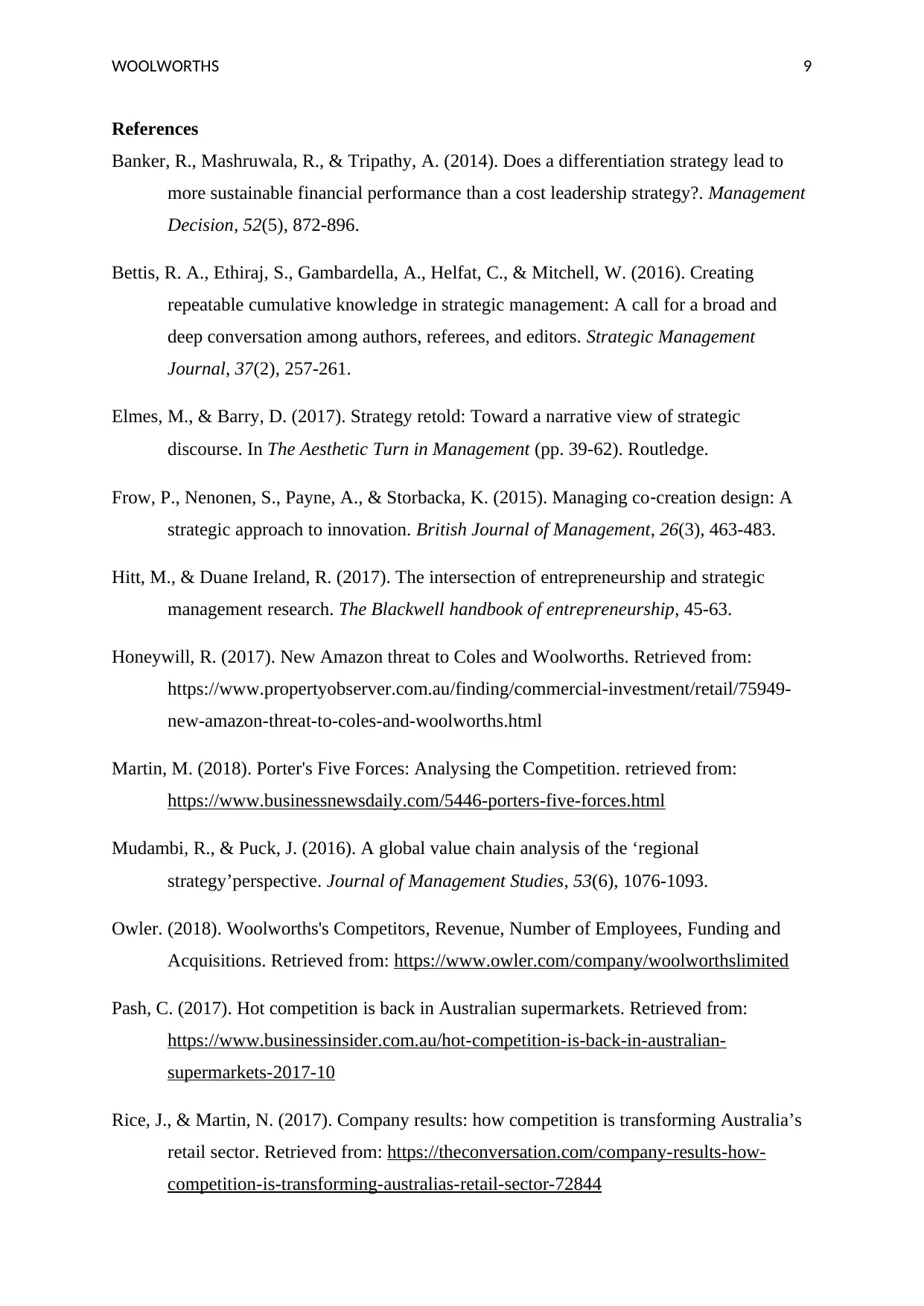
WOOLWORTHS 9
References
Banker, R., Mashruwala, R., & Tripathy, A. (2014). Does a differentiation strategy lead to
more sustainable financial performance than a cost leadership strategy?. Management
Decision, 52(5), 872-896.
Bettis, R. A., Ethiraj, S., Gambardella, A., Helfat, C., & Mitchell, W. (2016). Creating
repeatable cumulative knowledge in strategic management: A call for a broad and
deep conversation among authors, referees, and editors. Strategic Management
Journal, 37(2), 257-261.
Elmes, M., & Barry, D. (2017). Strategy retold: Toward a narrative view of strategic
discourse. In The Aesthetic Turn in Management (pp. 39-62). Routledge.
Frow, P., Nenonen, S., Payne, A., & Storbacka, K. (2015). Managing co‐creation design: A
strategic approach to innovation. British Journal of Management, 26(3), 463-483.
Hitt, M., & Duane Ireland, R. (2017). The intersection of entrepreneurship and strategic
management research. The Blackwell handbook of entrepreneurship, 45-63.
Honeywill, R. (2017). New Amazon threat to Coles and Woolworths. Retrieved from:
https://www.propertyobserver.com.au/finding/commercial-investment/retail/75949-
new-amazon-threat-to-coles-and-woolworths.html
Martin, M. (2018). Porter's Five Forces: Analysing the Competition. retrieved from:
https://www.businessnewsdaily.com/5446-porters-five-forces.html
Mudambi, R., & Puck, J. (2016). A global value chain analysis of the ‘regional
strategy’perspective. Journal of Management Studies, 53(6), 1076-1093.
Owler. (2018). Woolworths's Competitors, Revenue, Number of Employees, Funding and
Acquisitions. Retrieved from: https://www.owler.com/company/woolworthslimited
Pash, C. (2017). Hot competition is back in Australian supermarkets. Retrieved from:
https://www.businessinsider.com.au/hot-competition-is-back-in-australian-
supermarkets-2017-10
Rice, J., & Martin, N. (2017). Company results: how competition is transforming Australia’s
retail sector. Retrieved from: https://theconversation.com/company-results-how-
competition-is-transforming-australias-retail-sector-72844
References
Banker, R., Mashruwala, R., & Tripathy, A. (2014). Does a differentiation strategy lead to
more sustainable financial performance than a cost leadership strategy?. Management
Decision, 52(5), 872-896.
Bettis, R. A., Ethiraj, S., Gambardella, A., Helfat, C., & Mitchell, W. (2016). Creating
repeatable cumulative knowledge in strategic management: A call for a broad and
deep conversation among authors, referees, and editors. Strategic Management
Journal, 37(2), 257-261.
Elmes, M., & Barry, D. (2017). Strategy retold: Toward a narrative view of strategic
discourse. In The Aesthetic Turn in Management (pp. 39-62). Routledge.
Frow, P., Nenonen, S., Payne, A., & Storbacka, K. (2015). Managing co‐creation design: A
strategic approach to innovation. British Journal of Management, 26(3), 463-483.
Hitt, M., & Duane Ireland, R. (2017). The intersection of entrepreneurship and strategic
management research. The Blackwell handbook of entrepreneurship, 45-63.
Honeywill, R. (2017). New Amazon threat to Coles and Woolworths. Retrieved from:
https://www.propertyobserver.com.au/finding/commercial-investment/retail/75949-
new-amazon-threat-to-coles-and-woolworths.html
Martin, M. (2018). Porter's Five Forces: Analysing the Competition. retrieved from:
https://www.businessnewsdaily.com/5446-porters-five-forces.html
Mudambi, R., & Puck, J. (2016). A global value chain analysis of the ‘regional
strategy’perspective. Journal of Management Studies, 53(6), 1076-1093.
Owler. (2018). Woolworths's Competitors, Revenue, Number of Employees, Funding and
Acquisitions. Retrieved from: https://www.owler.com/company/woolworthslimited
Pash, C. (2017). Hot competition is back in Australian supermarkets. Retrieved from:
https://www.businessinsider.com.au/hot-competition-is-back-in-australian-
supermarkets-2017-10
Rice, J., & Martin, N. (2017). Company results: how competition is transforming Australia’s
retail sector. Retrieved from: https://theconversation.com/company-results-how-
competition-is-transforming-australias-retail-sector-72844
Paraphrase This Document
Need a fresh take? Get an instant paraphrase of this document with our AI Paraphraser
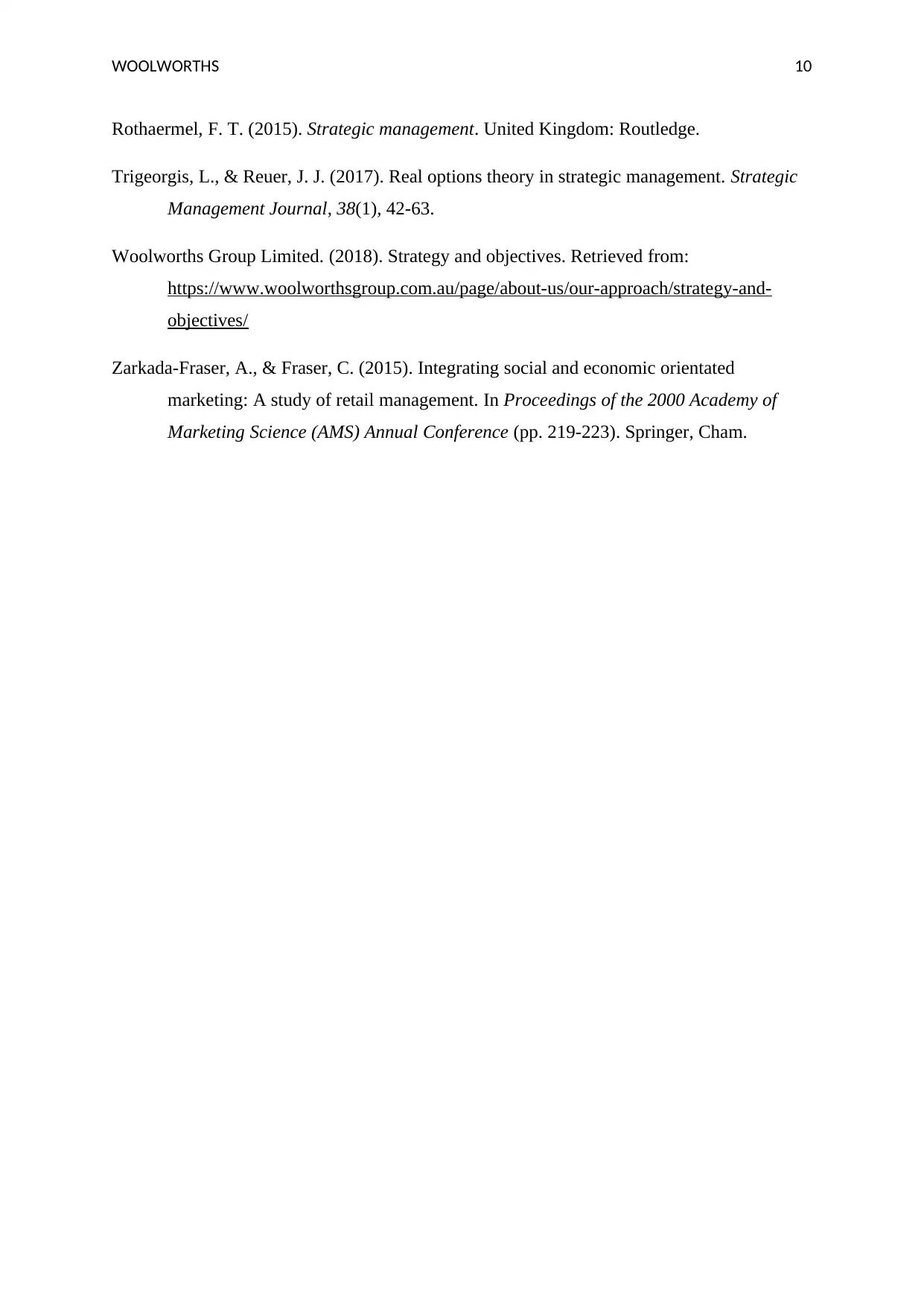
WOOLWORTHS 10
Rothaermel, F. T. (2015). Strategic management. United Kingdom: Routledge.
Trigeorgis, L., & Reuer, J. J. (2017). Real options theory in strategic management. Strategic
Management Journal, 38(1), 42-63.
Woolworths Group Limited. (2018). Strategy and objectives. Retrieved from:
https://www.woolworthsgroup.com.au/page/about-us/our-approach/strategy-and-
objectives/
Zarkada-Fraser, A., & Fraser, C. (2015). Integrating social and economic orientated
marketing: A study of retail management. In Proceedings of the 2000 Academy of
Marketing Science (AMS) Annual Conference (pp. 219-223). Springer, Cham.
Rothaermel, F. T. (2015). Strategic management. United Kingdom: Routledge.
Trigeorgis, L., & Reuer, J. J. (2017). Real options theory in strategic management. Strategic
Management Journal, 38(1), 42-63.
Woolworths Group Limited. (2018). Strategy and objectives. Retrieved from:
https://www.woolworthsgroup.com.au/page/about-us/our-approach/strategy-and-
objectives/
Zarkada-Fraser, A., & Fraser, C. (2015). Integrating social and economic orientated
marketing: A study of retail management. In Proceedings of the 2000 Academy of
Marketing Science (AMS) Annual Conference (pp. 219-223). Springer, Cham.
1 out of 11
Related Documents
Your All-in-One AI-Powered Toolkit for Academic Success.
+13062052269
info@desklib.com
Available 24*7 on WhatsApp / Email
![[object Object]](/_next/static/media/star-bottom.7253800d.svg)
Unlock your academic potential
Copyright © 2020–2025 A2Z Services. All Rights Reserved. Developed and managed by ZUCOL.





